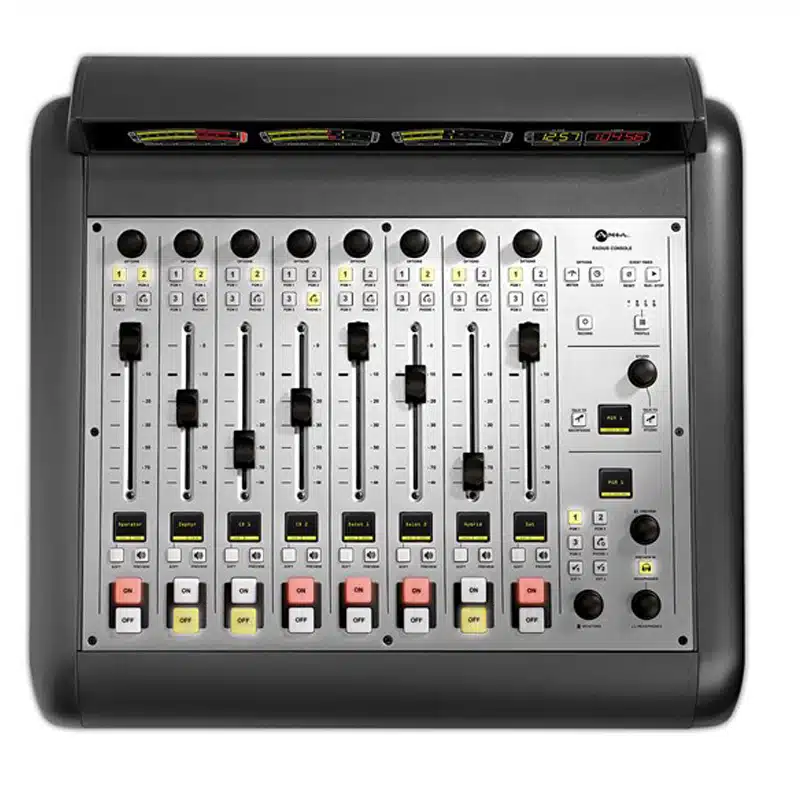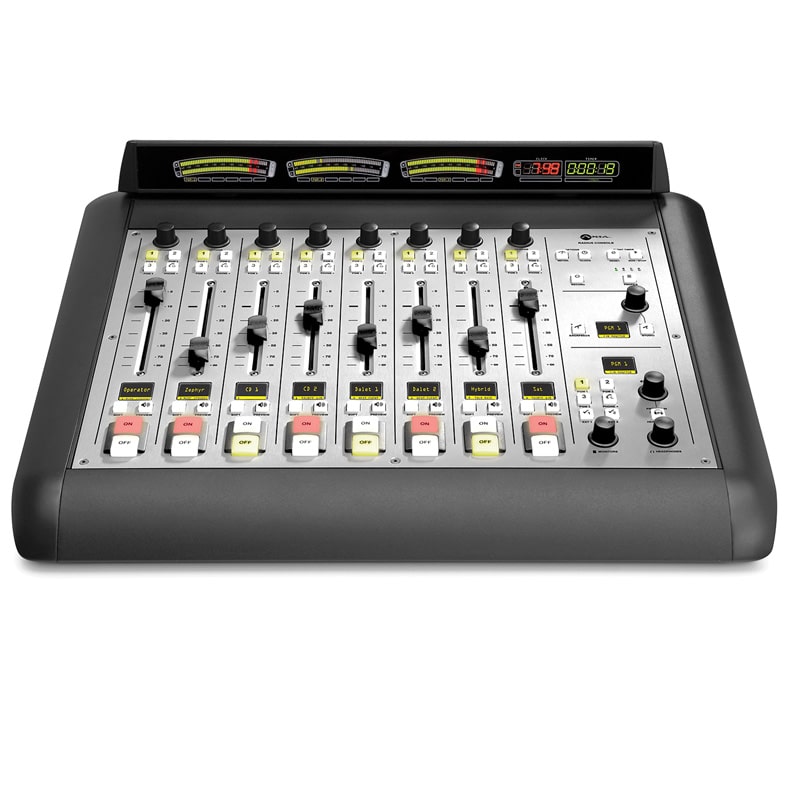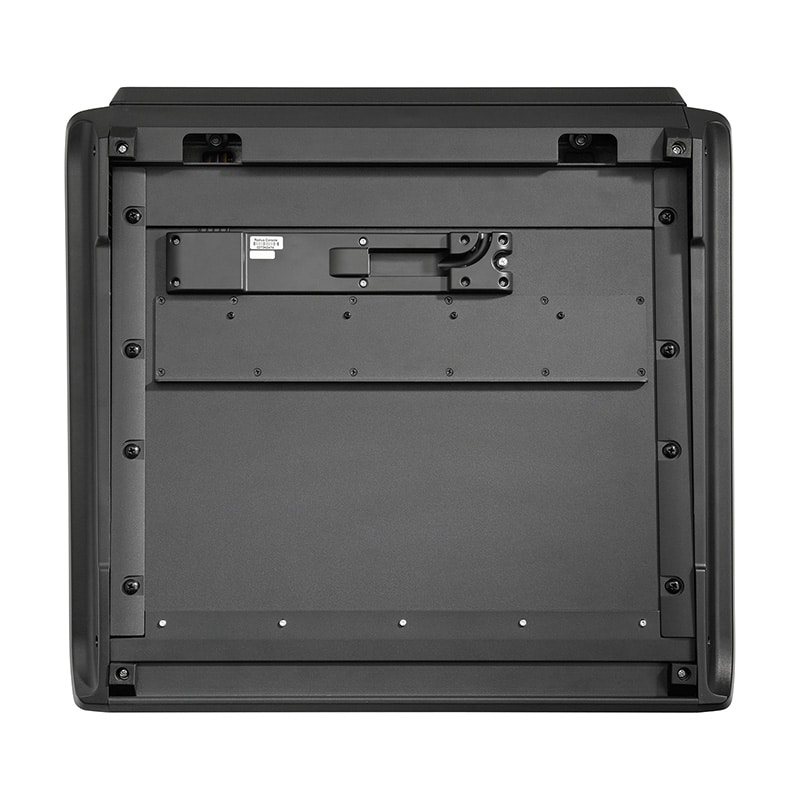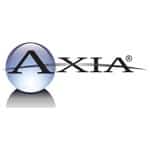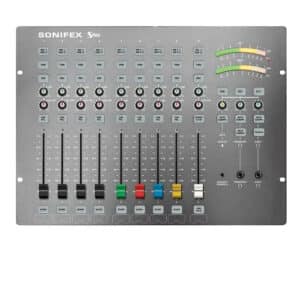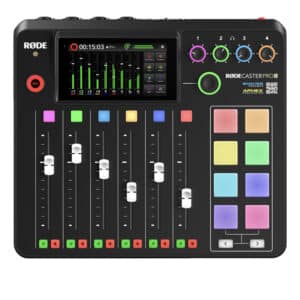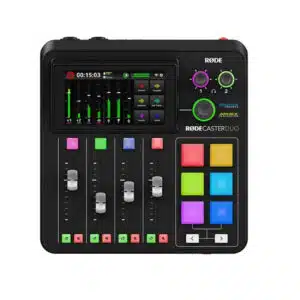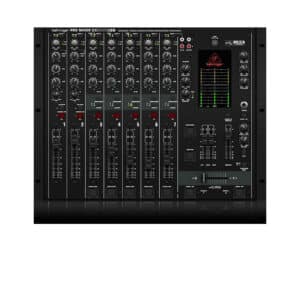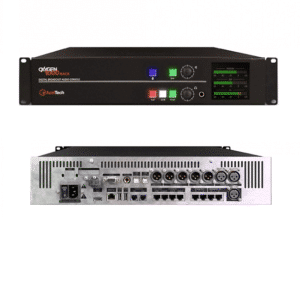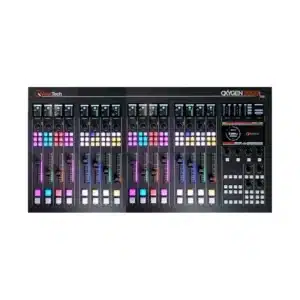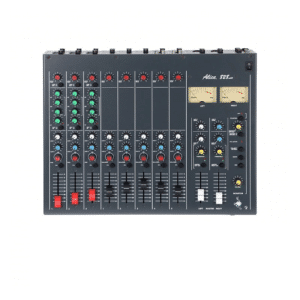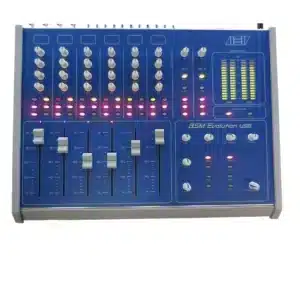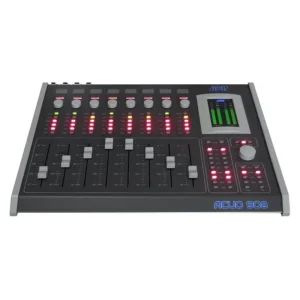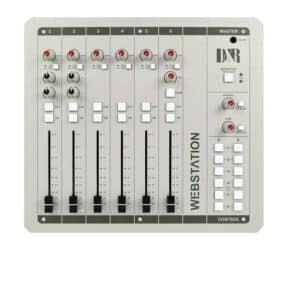Description
Axia Radius 8 Fader Digital Broadcast Mixer
Radius is an all-in-one console system designed for small standalone or networked studios, where no more than eight faders are needed. Like all Axia® consoles, it’s easy to deploy: each Radius control surface is powered by a burly QOR.16 integrated console engine with DSP-powered mixing engine, analog and digital audio I/O, custom Ethernet switch and GPIO ports. The Radius surface connects to the QOR.16 engine with a single CANBus cable.
Radius includes 4 stereo Program buses — 3 dedicated Program, Audition and Utility mixing outputs; the fourth a stereo Utility bus for recording phone callers or other off-air bits. The fourth bus may also be used as an additional Program bus. Automatic mix-minus is provided on each fader, plus talkback functions, one-button off-air Record Mode, Show Profile instant recall of up to 4 pre-defined console “snapshots”, LED bar-graph program meters switchable between VU and PPM meter styles, high- resolution OLED option displays on each fader, and Studio and Control Room monitor controls. Radius can be placed on top of desk surfaces, mounted drop-in style, or rack-mounted using included hardware.
- Two Mic inputs with switchable Phantom power,
- Eight Analog inputs,
- Four Analog outputs
- One AES/EBU input and output,
- Four GPIO logic ports for machine control of studio peripherals,
- Six 100Base-T ports for Livewire devices,
- Two Gigabit ports with SFP for connection to the outside worl
- QOR.16 Connections (Sold Separately)
- Microphone Inputs: 2x balanced XLR-F, with selectable Phantom power
- Analog Inputs: 8x RJ-45, StudioHub+ standard.
- Analog Outputs: 4x RJ-45, StudioHub+ standard.
- AES/EBU Inputs: 1x RJ-45, StudioHub+ standard.
- AES/EBU Outputs: 1x RJ-45, StudioHub+ standard.
- GPIO: 4x DB-15
- Livewire:
-
- 4x 100BASE-T with PoE, RJ-45
- 2x 100BASE-T, RJ-45
- 2x 1000BASE-T, RJ-45
- 2x Gigabit, SFP (Small Form Pluggable)
- Console Frame Connections: 1x, 6-pin “latch and lock” style
- Accessory Connections: 1x, 6-pin “latch and lock” style
Microphone Preamplifiers
-
-
- Source Impedance: 150 Ohms
- Input Impedance: 4 k Ohms minimum, balanced
- Nominal Level Range: Adjustable, -75 dBu to -20 dBu
- Input Headroom: >20 dB above nominal input
- Output Level: +4 dBu, nominal
-
Analog Line Inputs
-
-
-
- Input Impedance: 20 k Ohms
- Nominal Level Range: Selectable, +4 dBu or -10dBv
- Input Headroom: 20 dB above nominal input
-
-
Analog Line Outputs
-
-
-
-
- Output Source Impedance: <50 Ohms balanced
- Output Load Impedance: 600 Ohms, minimum
- Nominal Output Level: +4 dBu
- Maximum Output Level: +24 dBu
-
-
-
Digital Audio Inputs And Outputs
-
-
-
-
-
- Reference Level: +4 dBu (-20 dB FSD)
- Impedance: 110 Ohm, balanced (XLR)
- Signal Format: AES-3 (AES/EBU)
- AES-3 Input Compliance: 24-bit with selectable sample rate conversion, 20 kHz to 216kHz input sample rate capable.
- AES-3 Output Compliance: 24-bit
- Digital Reference: Internal (network timebase) or external reference 48 kHz, +/- 2 ppm
- Internal Sampling Rate: 48 kHz
- Output Sample Rate: 48 kHz
- A/D Conversions: 24-bit, Delta-Sigma, 256x oversampling
- D/A Conversions: 24-bit, Delta-Sigma, 256x oversampling
- Latency <3 ms, mic in to monitor out, including network and processor loop
-
-
-
-
Frequency Response
-
-
-
-
-
-
- Any input to any output: +0.5 / -0.5 dB, 20 Hz to 20 kHz
-
-
-
-
-
Dynamic Range
-
-
-
-
-
-
- Analog Input to Analog Output: 102 dB referenced to 0 dBFS, 105 dB “A” weighted to 0 dBFS
- Analog Input to Digital Output: 105 dB referenced to 0 dBFS
- Digital Input to Analog Output: 103 dB referenced to 0 dBFS, 106 dB “A” weighted
- Digital Input to Digital Output: 125 dB
-
-
-
-
-
Equivalent Input Noise
-
-
-
-
-
-
- Microphone Preamp: -128 dBu, 150 Ohm source, reference -50 dBu input level
-
-
-
-
-
Total Harmonic Distortion + Noise
-
-
-
-
-
-
- Mic Pre Input to Analog Line Output: <0.005%, 1 kHz, -38 dBu input, +18 dBu output
- Analog Input to Analog Output: <0.008%, 1 kHz, +18 dBu input, +18 dBu output
- Digital Input to Digital Output: <0.0003%, 1 kHz, -20 dBFS
- Digital Input to Analog Output: <0.005%, 1 kHz, -6 dBFS input, +18 dBu output
-
-
-
-
-
Crosstalk Isolation, Stereo Separation And CMRR
-
-
-
-
-
-
- Analog Line channel to channel isolation: 90 dB isolation minimum, 20 Hz to 20 kH
- Microphone channel to channel isolation: 80 dB isolation minimum, 20 Hz to 20 kHz
- Analog Line Stereo separation: 85 dB isolation minimum, 20Hz to 20 kHz
- Analog Line Input CMRR: >50 dB, 20 Hz to 20 kHz
- Microphone Input CMRR: >50 dB, 20 Hz to 20 kHz
-
-
-
-
-
Audio Processing
-
-
-
-
-
-
- Mic Equalizer (applicable to up to 6 faders)
- Frequency Bands: 20Hz to 320Hz, 125Hz to 2KHz, 1.25KHz to 20KHz.
- Cut/Boost range on each band: -25dB to +15dB.
- Q-factor: Automatic – bandwidth varies based on amount of cut or boost.
-
-
-
-
-
Power Supply AC Input, QOR.16 with Radius Console
-
-
-
-
-
-
- Auto-sensing supply, 100VAC to 240VAC, 50 Hz to 60 Hz, IEC receptacle, internal fuse
- Power consumption: 100 Watts
-
-
-
-
-
Operating Temperatures
-
-
-
-
-
-
- -10 degrees C to +40 degrees C, <90% humidity, no condensation
-
-
-
-
-
Dimensions
-
-
-
-
-
-
- 20.5” x 19” x 4.5” (desktop to meter bridge)
-
-
-
-
-
-
- Description
-
Axia Radius 8 Fader Digital Broadcast Mixer
Radius is an all-in-one console system designed for small standalone or networked studios, where no more than eight faders are needed. Like all Axia® consoles, it’s easy to deploy: each Radius control surface is powered by a burly QOR.16 integrated console engine with DSP-powered mixing engine, analog and digital audio I/O, custom Ethernet switch and GPIO ports. The Radius surface connects to the QOR.16 engine with a single CANBus cable.
Radius includes 4 stereo Program buses — 3 dedicated Program, Audition and Utility mixing outputs; the fourth a stereo Utility bus for recording phone callers or other off-air bits. The fourth bus may also be used as an additional Program bus. Automatic mix-minus is provided on each fader, plus talkback functions, one-button off-air Record Mode, Show Profile instant recall of up to 4 pre-defined console “snapshots”, LED bar-graph program meters switchable between VU and PPM meter styles, high- resolution OLED option displays on each fader, and Studio and Control Room monitor controls. Radius can be placed on top of desk surfaces, mounted drop-in style, or rack-mounted using included hardware.
- Specifications
-
- Two Mic inputs with switchable Phantom power,
- Eight Analog inputs,
- Four Analog outputs
- One AES/EBU input and output,
- Four GPIO logic ports for machine control of studio peripherals,
- Six 100Base-T ports for Livewire devices,
- Two Gigabit ports with SFP for connection to the outside worl
- QOR.16 Connections (Sold Separately)
- Microphone Inputs: 2x balanced XLR-F, with selectable Phantom power
- Analog Inputs: 8x RJ-45, StudioHub+ standard.
- Analog Outputs: 4x RJ-45, StudioHub+ standard.
- AES/EBU Inputs: 1x RJ-45, StudioHub+ standard.
- AES/EBU Outputs: 1x RJ-45, StudioHub+ standard.
- GPIO: 4x DB-15
- Livewire:
-
- 4x 100BASE-T with PoE, RJ-45
- 2x 100BASE-T, RJ-45
- 2x 1000BASE-T, RJ-45
- 2x Gigabit, SFP (Small Form Pluggable)
- Console Frame Connections: 1x, 6-pin “latch and lock” style
- Accessory Connections: 1x, 6-pin “latch and lock” style
Microphone Preamplifiers
-
-
- Source Impedance: 150 Ohms
- Input Impedance: 4 k Ohms minimum, balanced
- Nominal Level Range: Adjustable, -75 dBu to -20 dBu
- Input Headroom: >20 dB above nominal input
- Output Level: +4 dBu, nominal
-
Analog Line Inputs
-
-
-
- Input Impedance: 20 k Ohms
- Nominal Level Range: Selectable, +4 dBu or -10dBv
- Input Headroom: 20 dB above nominal input
-
-
Analog Line Outputs
-
-
-
-
- Output Source Impedance: <50 Ohms balanced
- Output Load Impedance: 600 Ohms, minimum
- Nominal Output Level: +4 dBu
- Maximum Output Level: +24 dBu
-
-
-
Digital Audio Inputs And Outputs
-
-
-
-
-
- Reference Level: +4 dBu (-20 dB FSD)
- Impedance: 110 Ohm, balanced (XLR)
- Signal Format: AES-3 (AES/EBU)
- AES-3 Input Compliance: 24-bit with selectable sample rate conversion, 20 kHz to 216kHz input sample rate capable.
- AES-3 Output Compliance: 24-bit
- Digital Reference: Internal (network timebase) or external reference 48 kHz, +/- 2 ppm
- Internal Sampling Rate: 48 kHz
- Output Sample Rate: 48 kHz
- A/D Conversions: 24-bit, Delta-Sigma, 256x oversampling
- D/A Conversions: 24-bit, Delta-Sigma, 256x oversampling
- Latency <3 ms, mic in to monitor out, including network and processor loop
-
-
-
-
Frequency Response
-
-
-
-
-
-
- Any input to any output: +0.5 / -0.5 dB, 20 Hz to 20 kHz
-
-
-
-
-
Dynamic Range
-
-
-
-
-
-
- Analog Input to Analog Output: 102 dB referenced to 0 dBFS, 105 dB “A” weighted to 0 dBFS
- Analog Input to Digital Output: 105 dB referenced to 0 dBFS
- Digital Input to Analog Output: 103 dB referenced to 0 dBFS, 106 dB “A” weighted
- Digital Input to Digital Output: 125 dB
-
-
-
-
-
Equivalent Input Noise
-
-
-
-
-
-
- Microphone Preamp: -128 dBu, 150 Ohm source, reference -50 dBu input level
-
-
-
-
-
Total Harmonic Distortion + Noise
-
-
-
-
-
-
- Mic Pre Input to Analog Line Output: <0.005%, 1 kHz, -38 dBu input, +18 dBu output
- Analog Input to Analog Output: <0.008%, 1 kHz, +18 dBu input, +18 dBu output
- Digital Input to Digital Output: <0.0003%, 1 kHz, -20 dBFS
- Digital Input to Analog Output: <0.005%, 1 kHz, -6 dBFS input, +18 dBu output
-
-
-
-
-
Crosstalk Isolation, Stereo Separation And CMRR
-
-
-
-
-
-
- Analog Line channel to channel isolation: 90 dB isolation minimum, 20 Hz to 20 kH
- Microphone channel to channel isolation: 80 dB isolation minimum, 20 Hz to 20 kHz
- Analog Line Stereo separation: 85 dB isolation minimum, 20Hz to 20 kHz
- Analog Line Input CMRR: >50 dB, 20 Hz to 20 kHz
- Microphone Input CMRR: >50 dB, 20 Hz to 20 kHz
-
-
-
-
-
Audio Processing
-
-
-
-
-
-
- Mic Equalizer (applicable to up to 6 faders)
- Frequency Bands: 20Hz to 320Hz, 125Hz to 2KHz, 1.25KHz to 20KHz.
- Cut/Boost range on each band: -25dB to +15dB.
- Q-factor: Automatic – bandwidth varies based on amount of cut or boost.
-
-
-
-
-
Power Supply AC Input, QOR.16 with Radius Console
-
-
-
-
-
-
- Auto-sensing supply, 100VAC to 240VAC, 50 Hz to 60 Hz, IEC receptacle, internal fuse
- Power consumption: 100 Watts
-
-
-
-
-
Operating Temperatures
-
-
-
-
-
-
- -10 degrees C to +40 degrees C, <90% humidity, no condensation
-
-
-
-
-
Dimensions
-
-
-
-
-
-
- 20.5” x 19” x 4.5” (desktop to meter bridge)
-
-
-
-
-
-

